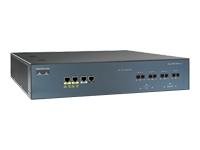Have questions? Call us now!
847-468-8900

Cisco Service Control Engine 2020 - network monitoring device
Cisco Service Control Engine 2020 - Network monitoring device - 4 ports - Fast Ethernet - 2U - external
The Cisco SCE 2000 Series Service Control Engine is designed for carrier-grade deployments that require high-capacity stateful application- and session-based classification and control of all network traffic. Powered by a patented architecture employing hardware acceleration and multiple high-speed Reduced Instruction Set Computer (RISC) processors, the Cisco SCE 2000 Series is at the nucleus of the Cisco Service Control technology solution. It is a high-performance, purpose-built traffic metering and control device with a highly programmable core that can track and manage up to 2 million concurrent unidirectional application flows over an IP network. This extensible network element is specifically designed for scalable control of application flows. Carriers and service providers deploy the Cisco SCE 2000 Series in high-performance metropolitan-area (metro), cable, DSL, mobile, or Wi-Fi networks to provide advanced application-level bandwidth optimization, management, and service control functions. The Cisco SCE 2000 Series resides at the edge of the network where two high-speed gigabit links are used for connecting aggregation access devices to the Internet backbone infrastructure. Residing at this critical part of the network, the Cisco SCE 2000 Series has a multitude of carrier-grade features to help ensure nonstop network availability and overall IP service control. Two cascaded Cisco SCE 2000 Series engines can be deployed on dual gigabit links to achieve high availability and failover without imposing any single point of failure. To achieve higher performance and maximum capacity, the Cisco SCE 2000 Series takes advantage of patented system logic and stateful deep packet inspection analysis technology. This solution provides state-based protocol monitoring that allows for the detection and control of virtually any network application, including: Web browsing, multimedia streaming, and peer-to-peer (P2P). The result is overall reduction of network congestion by optimizing application-level traffic, eliminating costly network link usage and infrastructure upgrades. Application and subscriber awareness become the foundation for the deployment of application tiers of service that can be based on content and premium IP service delivery.
